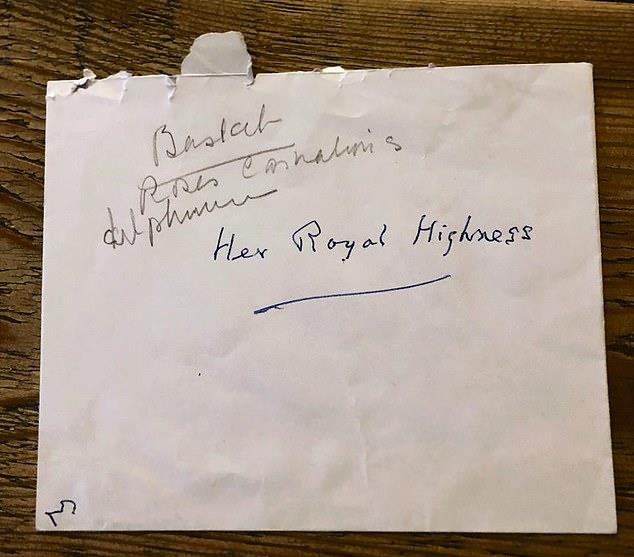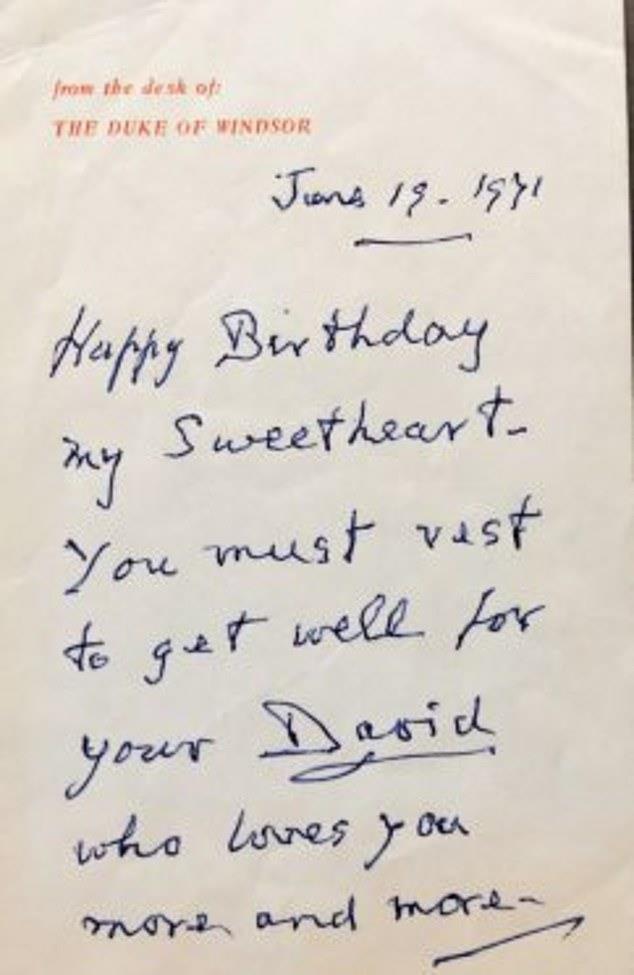
Anna was shown an envelope written for Wallis Simpson by the Duke of Windsor. He refers to Wallis as ‘Her Royal Highness’

The lost note I believe is touching proof love DID conquer all for the Windsors:
After writing a definitive book on Wallis Simpson, Anna Pasternak reveals how the duchess’s closest confidante shed new light on the infamous royal romance
• Anna Pasternak looked at royal romance between Duke and Duchess of Windsor
• The author questioned whether the romance was a Shakespearean tragedy
• Simpson’s confidante kept hold of correspondence between herself and Edward
When I finished writing The American Duchess, a book about Wallis Simpson, I was left with a niggling question. Did a genuine love emerge between the Duke and Duchess of Windsor as they surmounted the abdication together, or was the monumental sacrifice on both their parts a tragedy of Shakespearean proportions?
Edward VIII turned Wallis into the most hated woman in the world when, in 1936, he famously gave up the British throne to marry his true love, American divorcée Wallis. Surely there could be no greater act of love than to sacrifice all that imperial power, prestige and popularity for the heart of a woman?
Yet surely the greater act of love would have been for Edward to let Wallis go? The thought of the vicissitudes of her suffering never seemed to register with him.
As far as he was concerned, he could not live without her and could not see that she might not be able to live with the consequences of his single-mindedness. Being blamed in perpetuity for stealing a beloved king from his throne and almost destroying the British monarchy would prove to be a lifelong burden that Wallis was forced to bear.
What her detractors fail to acknowledge is that Wallis cherished Edward enough to let him go. She wrote to him in October 1936, when the king was pushing for her to divorce her second husband Ernest Simpson.
In her letter, she detailed how she must renounce her love for Edward (whom she called David when she became intimate with him – all his family called him David too) and in no uncertain terms tried to break with the king.
‘I am sure dear David that in a few months your life will run again as it did before and without my nagging. Also you have been independent of affection all your life.
‘We have had lovely times together and I thank God for them and know that you will go on with your job doing it better and in a more dignified manner each year. That would please me so. I am sure you and I would only create disaster together.’
Deaf to her entreaty, Edward announced his abdication just weeks later and spent the rest of his life in exile with Wallis. The couple lived with a laminated form of grief as it became clear that their previous existence was unrecoverable to them.
They never returned to live in England – which both longed for – while it was an agonising seam of pain for Edward that Wallis was denied the coveted HRH title. He addressed all his correspondence to his wife as Her Royal Highness, insisting that their staff curtsied to her and called her Your Royal Highness.
He was equally wounded that after the abdication, Queen Mary and his siblings refused to meet or accept Wallis, shunning their wedding in France.
After two years researching Wallis Simpson’s life, I concluded that the love affair between her and Edward was both an iconic story of sheer devotion and the heart-rending chronicle of the consequences of sacrifice.
I believe Wallis never wanted to marry the King of England. She was enthralled by his position, yet later maintained she would have preferred to have stayed in the shadows of history with Ernest Simpson.
Whether, as Ernest doubted, this would have sustained her after the excitement of royal favour is questionable. However, once trapped into marriage with Edward, burdened by his almost choking admiration, she did her best to make their life together as perfect as possible.
Now, however, I have an answer to my gnawing question. I have new, touching evidence that the Windsors’ marriage grew into a genuine love story.
After reading my book, which is now being made into a film, the Windsors’ private secretary Johanna Schutz contacted me last year. She is probably the last person alive who knew the Windsors intimately.
She went to work for them in Paris in 1969, when she was in her late 20s, becoming the adored daughter they never had.
I was thrilled when she got in touch with me because she said I had ‘captured the duchess perfectly’. I went to meet her in Spain, where she holidays, and for two days we talked solidly about the Windsors.
She described a couple steadfastly united, much in love. After the abdication, when the world turned against them, they turned towards each other. ‘If I had not seen a love like that, I would not have known it existed,’ she told me.
The Windsors’ friend, Diana Mosley, similarly said of Edward’s love for Wallis, ‘I think it is something quite unique for middle-aged and old people who have been married for over 30 years to be so completely in love as he was. She was devoted to him and did her utmost to make him happy, and that’s where she succeeded.’
Last month I went to see Johanna again, privileged to be invited to read her archival material. It is thanks to Johanna that the entire correspondence between Edward and Wallis was saved.
This haunting collection of love letters that documented the turbulent times they endured, from 1931-1937, was presented to Ms Schutz by the Windsors’ butler George in 1976. Apparently, Wallis had asked George to give them to Johanna so she could burn them.
Realising that she had history in her hands, Johanna refused, passing them instead to the Windsors’ lawyer, Maitre Blum, who published them in 1986 after Wallis’s death.
I, too, had history in my hands when Johanna gave me an envelope with Her Royal Highness written in shaky hand in pencil on it. Carefully opening it I pulled out a small piece of paper and, reading it, tears welled.
The headed paper says in discreet red print, ‘From the desk of: The Duke of Windsor.’ It was written on 19 June 1971 – the duchess’s birthday. Significantly, it was the last of her birthdays for which the duke was alive.
In his fragile hand, he has written what would be the last birthday billet doux to his adored Wallis. ‘Happy Birthday my Sweetheart. You must rest to get well for your David who loves you more and more.’
This note was found in papers the duchess bequeathed to Johanna. It has barely been seen and never before been published. Johanna gave it to me as a thank you for ‘all your efforts to rehabilitate our dear duchess, who deserves it more than anyone else’.
Earlier that month, on the third of June, the Windsors had celebrated their 34th – and final – wedding anniversary together. The duchess, almost 75, cut a gutsy dash, appearing at a party in a floor-length slit skirt over brown floral hot pants by Givenchy. Both knew, however, that the party was over.
I have come to love Wallis Simpson and feel outraged by her fictional alter ego. As her friend Herman Rogers said in 1936, when news of her affair with Edward broke, ‘Much of what is being said concerns a woman who does not exist and never did exist.’
The well-worn view is that she was nearly responsible for the downfall of the monarchy due to the constitutional crisis triggered by their marriage. We have experienced her so fully as Machiavellian that she has become a caricature of villainous womanhood.
As she herself said, ‘I who had sought no place in history would now be assured of one – an appalling one, carved out by blind prejudice.’
Thankfully, a forthcoming documentary produced by ITN Productions will seek to discover the real Wallis. It was also my aim to give her an authentic voice: to peel back the layers of prejudice and examine the wider motives for the enduring propaganda against her so that we might try to understand this modern, intelligent, remarkable woman.
She was, in fact, warm, funny, charming, loyal and dignified to the end. Adored by her many friends, she was written off by a British establishment who sought to diminish her.
Royal equerry Tommy Lascelles, familiar to viewers of The Crown for his sinister scheming, famously dismissed Wallis as ‘shop-soiled’ with ‘a voice like a rusty saw’. Along with British prime minister Stanley Baldwin, and Cosmo Lang, the Archbishop of Canterbury, they connived to destroy her reputation.
The unholy trinity of the government, church and palace did not want Edward, whom they considered weak and ill-disciplined, on the throne and they used Wallis to rid Britain of him. Wallis, wise to this, wrote to Edward post the abdication.
‘It is the politicians whose game it is… to build up the puppet they have placed on the throne. I was the convenient tool in their hands to get rid of you and how they used it!’
Ever since our current American duchess married Prince Harry, comparisons abound between Meghan and Wallis. Apart from both American divorcées being 34 when they met their princes and sharing a love of couture, what could unite them?
Both are seen as pushy women manipulating weaker, royal men. Yet the difference is that Wallis constantly tried to reunite Edward with his family, whereas Meghan appears determined to drive a wedge.
Wallis yearned to return to live in Britain, while it is doubtful Meghan will reside in the UK again.
Crucially, Wallis contained her suffering at the hands of the Royal Family with laudable dignity. She never spoke out against her flinty in-laws or encouraged devoted friends to settle scores.
She was unswervingly loyal to the end. If the Duchess of Sussex makes Prince Harry as happy as Wallis did Edward and they, too, celebrate 34 harmonious years of marriage together, then I will revise my view. Until then, only time and the hand of history will tell.